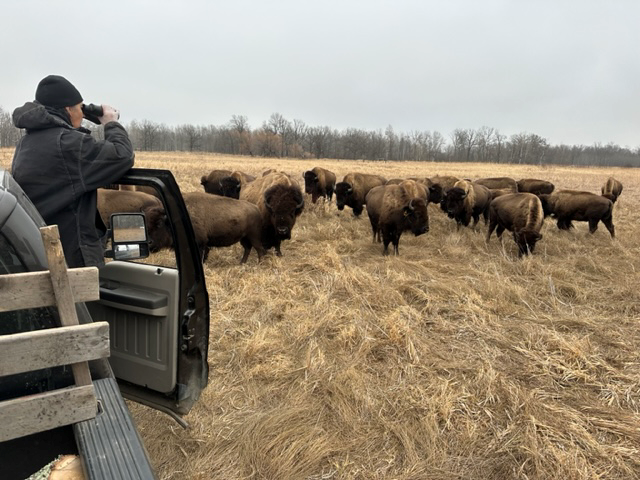Support for Existing Expertise: Community-focused training initiatives to improve the safety and health of Tribal buffalo herd workers
Posted on by
American bison, also known as buffalo, are the largest land mammal in North America and are perfectly adapted to the harsh landscape of the high plains, capable of surviving extreme winters, vast changes in temperature, drought conditions, high humidity, and many diseases that impact other hoofed mammals. In recent decades, indigenous communities across North America and organizations such as the Intertribal Buffalo Council (ITBC) have led efforts to bring the buffalo home to Tribal lands. This work is done with many goals in mind including ecological restoration, cultural and spiritual revitalization, economic growth, and food sovereignty.
However, buffalo are not domesticated and have not been bred for docility. They still exhibit their innate defensive strategies, including aggression and heightened vigilance in comparison with domesticated livestock like cattle. In flight or pursuit, buffalo can reach speeds up to 35 mph and are surprisingly agile given their large size. For these reasons, people working around buffalo are at risk for injury and exposure to zoonotic diseases, which are infections that can spread between animals and people. These risks and the growth of buffalo herding led to initial research which documented both hazards and health and safety best practices in buffalo herding. Now, a new research project seeks to build on past work and partnerships to create relevant and culturally appropriate safety and health training for buffalo herd workers.
The Central States Center for Agriculture Safety and Health (CS-CASH) at the College of Public Health in the University of Nebraska Medical Center is one of 11 regional Centers for Agricultural Safety and Health funded by the National Institute for Occupational Safety and Health. CS-CASH’s new project, “Establishing a Community-Based Training Network to Enhance Bison Herd Workers Safety on Tribal Lands” aims to support the people who do the hands-on work of managing Tribal buffalo herds by employing what was learned in previous work to:
1. Continue to monitor and understand workplace injuries, working conditions, and worker safety hazards for buffalo herd workers on Tribal lands;
2. Work with indigenous buffalo herd managers to ensure educational materials and training strategies are culturally relevant and appropriate; and
3. Help develop and support an indigenous-led training and mentorship program focused on worker and herd health.

The existing community of Tribal buffalo herd managers and workers contains the world’s foremost experts in buffalo herd management, harvesting, and processing. Tribes who are establishing their own herds may need trusted guidance and support as they work to establish their own programs. What has been lacking, however, is support for expert mentorship and training for these up-and-coming programs. This project intends to help provide this support and foster collaboration between experienced and less experienced tribal groups.
Improving Health and Safety Through Collaboration and Community
Health and safety hazards for buffalo herd workers include working with aging and repurposed equipment (often designed for cattle); working in remote locations during winter months; slip, trip and fall hazards; and high stress handling techniques. For the past five years, CS-CASH and the ITBC have worked together to hold an annual roundtable event which brings together experts and learners to discuss creative solutions, facilitate resource sharing, and document concerns regarding new and existing hazards to worker safety within the community.
Tribal communities have a strong interest in the safety and logistics surrounding cultural harvests and processing. Community events serve as an opportunity for the exchange of cultural knowledge, spiritual practice, as well as supporting community food sovereignty initiatives. This is also an opportunity to refine safety practices surrounding food preparation, to sample organs for disease and parasite monitoring, and to establish practices aimed at supporting the health and safety of the herd, the herd workers, and the broader community.
As the movement to bring bison back to Tribal lands continues to grow, we continue to work with Tribal herd workers and managers, ITBC, and other collaborators to enhance training materials, training opportunities, and support for community-led mentorship. Existing materials are available on the Central States Center for Agricultural Safety and Health (CS-CASH) website. Including annual reports summarizing discussions resulting from our annual roundtable events.
Mystera Samuelson, PhD, Assistant Professor, University of Nebraska Medical Center, College of Public Health, Department of Environmental, Agricultural, and Occupational Health
Arlo Iron Cloud Sr., Porcupine, SD Community Member
Lisa Iron Cloud, Porcupine, SD Community Member
KC Elliott, MA, MPH, Epidemiologist in the NIOSH Office of Agriculture Safety and Health.
Jessica Post, University of Nebraska Medical Center, Central States Center for Agricultural Safety and Health
Risto Rautiainen, PhD, MS, Professor, University of Nebraska Medical Center, College of Public Health, Director of Central States Center for Agricultural Safety and Health
Ellen Duysen, MPH, COHC, Assistant Research Professor, University of Nebraska, College of Public Health, Central States Center for Agricultural Safety and Health
John Gibbins, DVM, MPH, Senior Veterinary Advisor, NIOSH Office of Agriculture Safety and Health
| More information on ITBC
The InterTribal Buffalo Council (ITBC) is a collection of 80 tribes in 20 different states that facilitates the management of over 20,000 buffalo. Its members manage more than 32 million acres of Tribal lands and have restored buffalo to nearly 1 million of those acres. From the large intact grasslands of Montana to the small desert herds of New Mexico, ITBC is committed to reestablishing buffalo herds on Tribal lands in a manner that promotes cultural enhancement, spiritual revitalization, ecological restoration, and economic development. |
This research is done under research cooperative agreement award U54OH010162 supported by the Centers for Disease Control and Prevention National Institute for Occupational Safety and Health (CDC/NIOSH) under CDC funding opportunity RFA-OH-22-002. The contents are those of the author(s) and do not necessarily represent the official views of, nor an endorsement, by CDC/HHS, or the U.S. Government.
Posted on by

